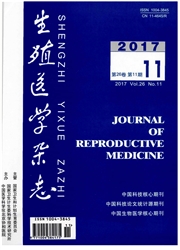

 中文摘要:
中文摘要:
目的 通过1例17α-羟化酶/17,20碳链裂解酶缺陷症(17-OHD)合并睾丸精原细胞瘤患者的临床及分子生物学研究,并结合文献复习该病的发病机理.方法 患者21岁,社会性别女性,临床诊断17-OHD.收集患者的临床资料、生化检查、影像学检查、病理结果.取患者外周血白细胞,提取基因组DNA,聚合酶链反应(PCR)扩增CYP17A1基因的8个外显子及其内含子的边界,并通过测序确定突变位点和性质.结果 患者临床表现、实验室检查、内分泌功能试验、影像学检查、病理等符合17-OHD合并睾丸精原细胞肿瘤的诊断.CYP17A1 基因序列分析发现该患者携带CPY17A1基因为复合杂合突变,分别为第8外显子缺失3个氨基酸(D487~F489)和第6外显子第329密码子TAC→AA,致成其后的移码突变,并提前产生一终止密码子(418TGA).结论 通过该患者临床诊治,使我们对该疾病的认识进一步加深;通过CYP17A1基因突变分析,从分子遗传学方面证实患者的诊断.
 英文摘要:
英文摘要:
Objective: To analyze the clinical and molecular genetic characteristics of a patient combined 17a- hydroxylase/17, 20 lyase deficiency (17-OHD) with testicular seminoma. Methods. Clinical features and laboratory data were collected. Genomic DNA was extracted from leukocytes of peripheral blood of the patient. All eight coding exons of CYP17A1 were amplified by PCR and sequenced. Results. 17-OHD with testicular seminoma was diagnosed by comprehensive consideration of the clinical presentations, lab tests, endocrinal functions, and the pathology of tumor. A mutation was identified with nine base deletion at excode 8 and a base transversion (TAC/AA) at excode 6 that produced a missense mutation. Conclusions. Through CYP17A1 gene mutation analysis, the diagnosis of 17-OHD with testicular seminoma was confirmed in the patient.
 同期刊论文项目
同期刊论文项目
 同项目期刊论文
同项目期刊论文
 期刊信息
期刊信息
